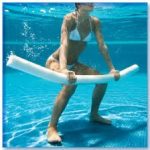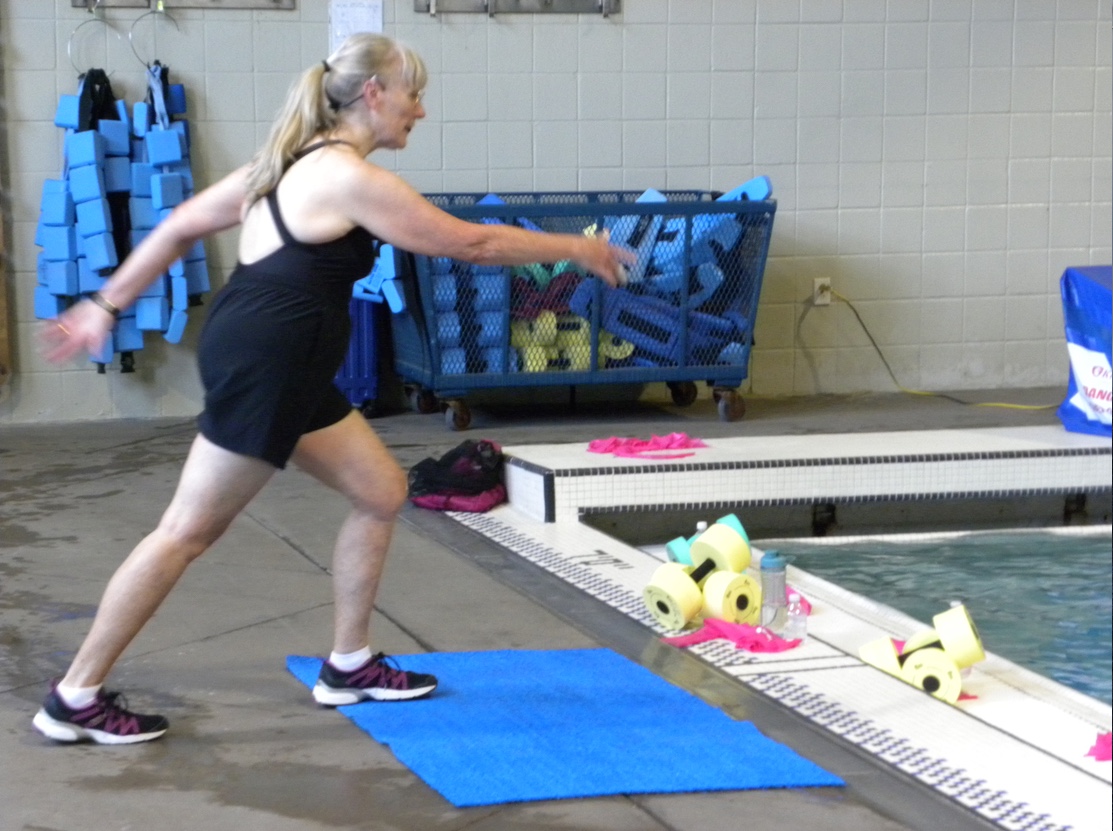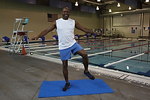

Noodles are popular in water fitness. Often we think of using noodles for support during suspended exercises in shallow water. Of course we can do those same exercises without a noodle in deep water because we are already supported by a deep water belt. In both shallow and deep water noodles can also be used as a piece of buoyant resistance equipment. Buoyant means that the equipment floats toward the water’s surface. Buoyant equipment is only offering resistance when you are plunging it toward the pool floor.
The colorful noodles available at most pools do not offer a great deal of resistance making them ideal for beginners and for whenever you plan to do many repetitions of an exercise. When greater resistance is desired, some people tie the noodle in a knot to increase its surface area. I am not a big fan of that because it makes the noodle curly and useless for any other purpose. A better option is to use the larger more dense foam noodles available from Hydro-Fit. You can also progress to using foam dumbbells instead of noodles.
to increase its surface area. I am not a big fan of that because it makes the noodle curly and useless for any other purpose. A better option is to use the larger more dense foam noodles available from Hydro-Fit. You can also progress to using foam dumbbells instead of noodles.
Since the resistance of a noodle occurs only when you are plunging it toward the pool floor, you need to be aware that you can only work one muscle of a muscle pair with this equipment. Hold the noodle in both hands with the palms facing up and perform an arm curl. You might think you are training the biceps, because that is what you would be training with weighted dumbbells in the gym. But the noodle wants to float to the surface anyway, so you are not using the biceps at all. Pull the noodle down toward the floor as if you are lowering weighted dumbbells and you are using the triceps, because the noodle is resisting that downward movement. Since the “arm curl” works the triceps, I prefer to turn the palms down (which puts less stress on the fingers), press the noodle toward the floor and call the exercise a “triceps extension.” The triceps contract concentrically in this exercise. If you slow down the noodle’s flotation toward the surface of the water, the triceps work eccentrically. If you wish to work the biceps, you may need to use a different kind of equipment.
Noodle resistance exercises can be performed with the noodle held in both hands (make sure the hands are shoulder distance apart), with the noodle held in one hand, and with the noodle under one foot. Some examples of strength training exercises you can do in shallow water with the noodles are:
- The chest press is shown in the Hydro-Fit drawing above. The exerciser is performing a rocking horse along with the chest press.
- The lat-pull down is being demonstrated by the instructor on the deck. The noodle is held in one hand extended to the side and is pressed down toward the floor.
- The squat is shown in the picture with a Hydro-Fit noodle. The noodle is being held down with the hands while the squat is performed, resisting the downward phase of the squat.
Shallow-water exercises with noodles need to be modified for deep water. For example, you cannot perform a rocking horse in deep water. However, you can do a chest press while leaning forward 45 degrees. A flutter kick in this position may help you stabilize while focusing on the pectoral muscles of the chest. Jog while performing the lat pull-down. The noodle will force you to travel sideways creating a challenge for the core muscles to maintain neutral posture while the lats are being trained. You cannot do squats in deep water, but you can place the noodle under one foot and perform a standing leg press.
For a chart showing which muscles are being trained with various exercises using buoyant equipment, see my new book Water Fitness Progressions. The book also contains lesson plans using noodles for both shallow water and deep water classes. The book can be ordered from Human Kinetics (the publisher) or from Amazon.com. Just click on whichever source you wish to order from and the link will take you there. Another resource for exercises with noodles is The Noodle Workout which is available from Hydro-Fit. Click on the Hydro-Fit link to order the booklet.
Have fun with your noodles! See you in the pool!

Chris Alexander





 I like my class participants. Over the years I’ve heard about their families, their pets, their challenges, and which of my playlists they like. They are more than just class participants, they are friends. I want them to get a good, safe, effective workout every time they come to my class. I don’t want to bore them with the same old routines. I want to challenge them to progress in their levels of fitness. I want to help them make their hearts stronger, to give them an opportunity to improve their muscular endurance, to challenge them mentally, and I want them to have fun doing it.
I like my class participants. Over the years I’ve heard about their families, their pets, their challenges, and which of my playlists they like. They are more than just class participants, they are friends. I want them to get a good, safe, effective workout every time they come to my class. I don’t want to bore them with the same old routines. I want to challenge them to progress in their levels of fitness. I want to help them make their hearts stronger, to give them an opportunity to improve their muscular endurance, to challenge them mentally, and I want them to have fun doing it.





 This is the sixth in a series of Blog posts on choreography. The last post described block choreography, which happens to be my favorite choreography style. I included a sample of simple block choreography, using 6 basic exercises. The 6 exercises are:
This is the sixth in a series of Blog posts on choreography. The last post described block choreography, which happens to be my favorite choreography style. I included a sample of simple block choreography, using 6 basic exercises. The 6 exercises are:




